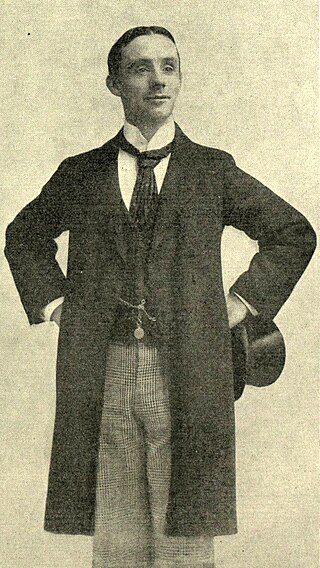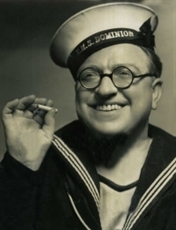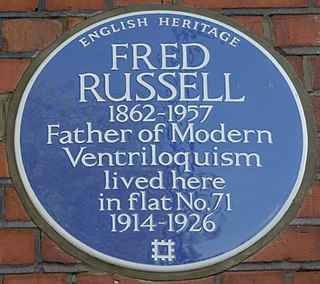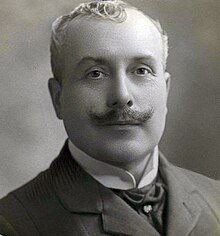
Ventriloquism or ventriloquy, is a performance act of stagecraft in which a person creates the illusion that their voice is coming from elsewhere, usually through a puppet known as a "dummy". The act of ventriloquism is ventriloquizing, and the ability to do so is commonly called in English the ability to "throw" one's voice.

Music hall is a type of British theatrical entertainment that was most popular from the early Victorian era, beginning around 1850, through the Great War. It faded away after 1918 as the halls rebranded their entertainment as variety. Perceptions of a distinction in Britain between bold and scandalous Music Hall and subsequent, more respectable Variety differ. Music hall involved a mixture of popular songs, comedy, speciality acts, and variety entertainment. The term is derived from a type of theatre or venue in which such entertainment took place. In North America vaudeville was in some ways analogous to British music hall, featuring rousing songs and comic acts.

George Wild Galvin, better known by the stage name Dan Leno, was a leading English music hall comedian and musical theatre actor during the late Victorian era. He was best known, aside from his music hall act, for his dame roles in the annual pantomimes that were popular at London's Theatre Royal, Drury Lane, from 1888 to 1904.

Peter Brough was an English radio ventriloquist who became a well-known name to audiences in the 1950s. He is associated with his puppet Archie Andrews.

Albert Arthur Powell MBE, known as Sandy Powell, was an English comedian best known for his radio work of the 1930s and for his catchphrase "Can you hear me, mother?" He first said this in a theatre in Coventry. Fifty years later, deciding he needed a rest from the business, he again said it in a Coventry theatre, for the last time.

Wenceslao Moreno Centeno, known professionally as Señor Wences, was a Spanish ventriloquist and comedian. His popularity grew with his frequent television appearances on CBS's The Ed Sullivan Show during the 1950s and 1960s. Later, he became popular with another generation of fans on The Muppet Show.

Thomas Frederick Parnell OBE, known professionally as Fred Russell, was an English ventriloquist. Usually credited as being the first to use a knee-sitting figure, he is known as "The Father of Modern Ventriloquism".
Thomas Barrasford (1859–1910) was a 19th-century British entrepreneur and entertainment impresario, who operated and built a number of theatres across Britain, mainly under the Barrasford Halls brand.
Ronn Lucas is an American ventriloquist and stand-up comedian.

John Walcott Cooper, Jr. was an American ventriloquist, entertainer, and singer with the Southern Jubilee Singers. He was known as the "Black Napoleon of Ventriloquism" and also performed under the pseudonym Hezekiah Jones. Over the course of his lifetime Cooper was a member of the Negro Actors Guild of America, the Colored Vaudeville Benevolent Association, and the International Brotherhood of Ventriloquists.

Arthur Wilkinson Worsley was a British ventriloquist who appeared regularly on British television from the 1950s to the 1970s. His act with dummy Charlie Brown had Charlie do all the talking, while Worsley himself remained "silent".

The Tivoli Circuit was a successful and popular Australian vaudeville entertainment circuit featuring revue, opera, ballet, dance, singing, musical comedy, old time black and white minstrel and even Shakespeare which flourished from 1893 to the 1950s, and featured local and international performers from the United States and the United Kingdom.
Terri Rogers was a transgender English ventriloquist and magician.

Walter Lawrence Emden was one of the leading English theatre and music hall architects in the building boom of 1885 to 1915.

Herbert Campbell, born Herbert Edward Story, was an English comedian and actor who appeared in music hall, Victorian burlesques and musical comedies during the Victorian era. He was famous for starring, for many years, in the Theatre Royal, Drury Lane's annual Christmas pantomimes, predominantly as a dame.
Timothy Selberg is a sculptor of three-dimensional carved mechanized figures, most of which are specifically used in the performance of ventriloquism. Selberg and his team at Selberg Studios, Inc. create handcrafted and custom carved works of art for collectors and entertainers.
Valentine Vox is a British born American ventriloquist and author known for his scholarly book on the history of ventriloquism, I Can See Your Lips Moving: the history and art of ventriloquism, which traces the practice back some three thousand years.
Arthur Prince was an English music hall entertainer and ventriloquist.

Johnny Danvers was an English actor, comedian and music hall performer who made a number of appearances in the annual pantomime at the Theatre Royal, Drury Lane in the late 19th and early 20th-centuries, usually with his nephew Dan Leno.
Fred Neiman was an English ventriloquist, music hall performer, and variety agent.




















